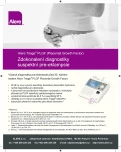Intrauterine fetal death syndrom: analysis of cases from 2008 to 2012 in Institute for the care of mother and child
Authors:
J. Klikarová; K. Šnajbergová; A. Měchurová; P. Velebil; J. Feyereisl
Authors‘ workplace:
Ústav pro péči o matku a dítě, Praha, ředitel doc. MUDr. J. Feyereisl, CSc.
Published in:
Ceska Gynekol 2014; 79(2): 120-127
Overview
Objective:
We made an analysis of number of intrauterine fetal deaths in our institute, it´s causes, risk factors and patient´s main complaints.
Methods:
Retrospective study of all intrauterine fetal deaths in Institute for the care of mother and child in years 2008–2012.
Results:
We had 60 cases of intrauterine fetal death from 2008 to 2012 which represented 2.4‰ of all deliveries (24884). The examination started in 45% of cases due to information about decreased fetal movements, 28.3% was diagnosed during regular visit, 13.3% came for contractions, 10% because of PPROM and 3.3% due to vaginal bleeding. In 58.3% we used induction of delivery, in 10% delivery started spontaneously and in 31.7% a caesarean section was performed.
Conclusion:
Decrease in fetal movements was the most frequent complaint of our patients. Spontaneously delivered 68.3% patiens, caesarean section was indicated in twins, due to maternal diseases or from vital indication. In 70% of cases we approved the cause of intrauterine fetal death. Mostly umbilical cord or placental abnormalities were present.
Keywords:
intrauterine fetal death, causes, risk factors
Sources
1. Alfirevic, Z., Roberts, D., Martlew, V. How strong is the association between maternal thrombophilia and adverse pregnancy outcome? A systematic review. Eur J Obstet Gynecol Reprod Biol, 2002, 101, p. 6–14.
2. Allen, VM., Joseph, K., Murphy, KE., et al. The effect of hypertensive disorders in pregnancy on small for gestational age and stillbirth: a population based study. BMC Pregnancy Childbirth. 2004, 4, p. 17.
3. Bateman, BT., Simpson, LL. Higher rate of stillbirth at the extremes of reproductive age: a large nationwide sample of deliveries in the United States. Am J Obstet Gynecol, 2006, 194, p. 840–845.
4. Black births. Available at: http://www.state.ma.us/dph/bhsre/resp/resep Accessed on December 12, 2002.
5. Clauson, B., Gardosi, J., Francis, A. Perinatal outcome in SGA births defined by customised versus population-based birthsweight standards. BJOG, 2001, 108, p. 830–834.
6. Cundy, T., Gamble, G., Townend, K., et al. Perinatal mortality in type 2 diabetes mellitus. Diabet Med, 2000, 17, p. 33–39.
7. Faye-Petersen, ON., Guin, DA., Wenstorm, KD. Value of perinatal autopsy. Obstet Gynecol, 1999, 94, p. 915–920.
8. Fleisch, MC., Thomas Hoehn, J. Intrauterine fetal death after multiple umbilical cord torsion – complication of a twin pregnancy following assisted reproduction. Assist Reprod Genet, 2008, 25(6), p. 277–279.
9. Fretts, RT. Etiology and prevention of stillbirth. Am J Obstet Gynecol, 2005, 193, p. 1923–1935.
10. Goldenberg, RL., Thompson, C. The infectious origin of stillbirth. Am J Obstet Gynecol, 2003, 189, p. 861–873.
11. Huang, DY., Usher, RH., Kramer, MS., et al. Determinants of unexplained antepartum fetal deaths. Obstet Gynecol, 2000, 95, p. 215–221.
12. Jacobsson, B., Ladfors, L., Milsom I. Advanced maternal age and adverse perinatal outcome. Obstet Gynecol, 2004, 104, p. 727–733.
13. Kristensen, J., Vestergaard, M., Wisborg, K., et al. Pre-pregnancy weight and the risk of stillbirth and neonatal death. BJOG, 2005, 112, p. 403–488.
14. Laube, DW., Schauberger, CW. Fetomaternal bleeding a cause for „unexplained“ fetal death. Obstet Gynecol, 1982, 60, p. 649–651.
15. Leduc, L. Stillbirth and bereavement: guidelines for stillbirth investigation. JOGC, 2006, 178, p. 540–544.
16. Liu, S., Josef, KS., Kramer, MS., et al. Relationship of prenatal diagnosis and preganancy termination to overall infant mortality in Canada. JAMA, 2002, 287, p. 1561–1567.
17. Ľubušký, M., Pospíšilová, D., Hyjánek, J., et al. Prenatální infekce plodu parvovirem B19. Čes Gynek, 2005, 70(4), s. 306–311.
18. Maasilta, P., Bachour, A., Teramo, K., et al. Sleep-related disordered brething during pregnancyin obese women. Chest, 2001, 120, p. 1448–1454.
19. McCowan, LME., Dekker, GA., Chan, E., et al. Spontaneous preterm birth and small for gestational age infants in women who stop smoking early in preganancy: prospective cohort study. BMJ, 2009, 338, p. b1081.
20. Mertinelli, IT., Cetin, E., Marioni, A., et al. Mutations in coagulation factors in women with unexplained late fetal loss. N Engl J Med, 2000, 343, p. 1015–1018.
21. Nechanská, B., Mravčík, V., Sopko, B., Velebil, P. Rodičky užívající alkohol, tabák a nelegální drogy. Čes Gynek, 2012, 77(5), p. 457–469.
22. Odendaal, HJ., Hall, DR., Grové, D. Risk factors for an perinatal mortality of abruption placentae in patients hospitalised for early onset severe pre-eclampsia – a case controlled study.J Obstet Gynaecol, 2000, 20(4), p. 358–364.
23. Saade, GR., McLintock, C. Inherited trombophilia and stillbirth. Semin Perinatol, 2002, 26, p. 51–69.
24. Shankar, M., Navti, O., Amu, O., Konje, JC. Assessment of stillbirth risk and associated risk factors in a tertiary hospital.J Obstet Gynaecol, 2002, 22, p. 34–38.
25. Silver, RM. Fetal death. Obstet Gynecol, 2007, 109(1), p. 153.
26. Silver, RM., Varner, MW., Reddy, U., et al. Work-up of stillbirth: a revue of evidence. Am J Obstet Gynecol, 2007, 196(5), p. 433–444.
27. Sun, Y., Arbuckle, S., Hocking, G., Billson, V. Umbilical cord stricture and intrauterine fetal death. Pediatr Pathol Lab Med, 1995, 15(5), p. 723–732.
28. Wapner, RJ., Lewis, D. Genetics and metabolic causes of stillbirth. Semin Perinatol, 2002, 26, p. 70–4.
29. Wylie, BJ., D’Alton, ME. Fetomaternal hemorrhage. Obstet Gynecol, 2010, 115(5), p. 1039–1051.
Labels
Paediatric gynaecology Gynaecology and obstetrics Reproduction medicineArticle was published in
Czech Gynaecology

2014 Issue 2
Most read in this issue
- Intrauterine fetal death syndrom: analysis of cases from 2008 to 2012 in Institute for the care of mother and child
- New views on the functional morphology of human clitoris
- Breech presentation – an analysis of resultsin one perinatal center
- Folic acid and prevention of the neural tube defects
